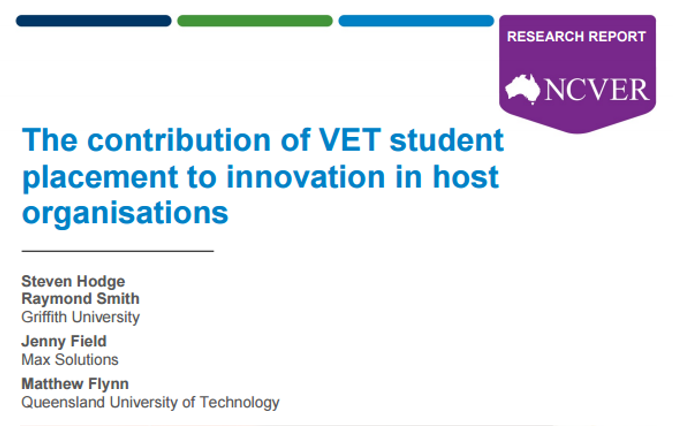Your Cart
Member Lunchbox Webinars
As a Member you get access to over 20 hours of additional recorded webinar content.
VET News
This week in VET
Bridge Climb Sydney
Jul 5, 2017
Exploring the 2017 NVC Master Classes
Jul 6, 2017
Only 11 Standard and 1 Premium Sponsor places left at the #2017NVC
Jul 5, 2017
ASQA Releases Report into Strategic Review
Jul 6, 2017
Bye-bye VET FEE-HELP; New Phase of VET Student Loans Underway
Jul 6, 2017
2017 Virtual VET Summit - RTO Management and Compliance
Jul 6, 2017
Stretch Your Mind with NVC PD
Jul 6, 2017
Careers Australia in Liquidation
Jul 6, 2017
New NCVER Report Highlights Contributions of VET Students to Host Organisations
Jul 6, 2017
National VET Regulator Cancels Provider Registrations
Jul 6, 2017
NSW Government VET Repositioning Campaign
Jul 6, 2017
AISC Updates
Jul 6, 2017
Court Finds Unique was Misleading and Unconscionable
Jul 6, 2017
VET Newsletters 6 July 2017
Jul 6, 2017
Media Releases 6 July 2017
Jul 6, 2017
Amendment to the Standards for RTOs – Implications for Trainers and Assessors
Jul 6, 2017
New NCVER Report Highlights Contributions of VET Students to Host Organisations

In a new report released from NCVER, four case studies were used to explore whether student placement can contribute to innovation of the host organisation.
Whilst the case studies did not provide unequivocal evidence of individual students contributing to innovation in the workplace, it did find that the definition of ‘innovation’ (according to the Australian Bureau of Statistics) constrained noted instances of this during the process. The study did find however, that an expansion of the definition to ‘practice innovation’, meant there was evidence that the student placement process may play a role in making improvements to the organisation.
The impacts and peripheral benefits to an organisation of taking on students were somewhat surprising. For example, interestingly, the report found that, while students were generally not able to contribute to innovation per se, there were examples of knowledge diffusion (students bringing new and updated knowledge into their host organisations) and of students making small-scale local improvements in the workplace. The new knowledge and skills acquired by students in their formal studies were sometimes more up to date than those possessed by staff.
Data from the research suggested that improvements for host organisations come from the flexibility that the placement process as a whole can offer organisations to respond to changes in their environment.
Organisational agility is crucial for responding to opportunities in volatile environments and considered an important element in organisational innovation. For the organisations in the study, VET student placement played a central role. Strong relationships between providers and host organisations, planning, investment and the ‘buy in’ of supervising staff to the placement process, were all found to support positive outcomes.
The researchers made the following suggestions for making fuller use of VET student placement as a knowledge-diffusion mechanism and a driver of practice innovation:
- Stereotypes about VET placement students should be challenged. Stereotypes, including the idea that learners do not possess the knowledge or skills to contribute to improvements and that it is inappropriate for students to make suggestions, serve to block the diffusion of knowledge and practice innovation. These stereotypes can be found among VET students, provider staff and host organisation staff.
- Providers should encourage students to make suggestions in appropriate ways if the students see potential for improvement during their placements. Providers often share the assumption that learners are best limited to observing and absorbing information and practices while on placement. Assessment task projects that involve the introduction of new ideas, processes and practices in host organisations can be a way of realising the potential of student placement as a driver of innovation.
- Host organisations should also encourage placement students to make suggestions for improvement if students see the potential, and should ensure that clear systems are in place to gather suggestions. While many host organisation staff were amenable to receiving suggestions and feedback from placement students, the students were not always aware that this possibility was available to them and were also unsure about the process for making suggestions if they saw potential for improvement.
- Host organisations should take measures to ensure that contributions to knowledge and practice at the local level can be shared widely through the organisation. The research suggests that knowledge and practice contributions do not necessarily spread from the local level.
- Host organisations and providers could work together to challenge stereotypes, encourage suggestions for improvement from placement students and identify mechanisms for disseminating knowledge and practice improvements at the local level. At present, strong relationships between providers and organisations ensure that a number of benefits arise from the student-placement process, including facilitating organisational agility, but mechanisms could also be established to realise the potential that student placement has to contribute to innovation.
For more information, you can view the:
- NCVER website; and
- Report.
Date posted Jul 6, 2017
Contact us
Need some help? Visit our help section to get answers to your questions.
Why join?
Our vision is to educate, inspire, and empower by providing quality, flexible and innovative products and services - the Velg Training membership program is no exception. Packed full of exclusive benefits, our membership program provides access to a range of member-only privileges. Watch now to hear more about these privileges!
Already a member?
Benefit from a free Velg Training profile and receive our fortnightly newsletter
All the great benefits of membership extend to the named individual
Benefits extended to unlimited sibling accounts
+
Account administrator to manage team
+
Track sibling PD history